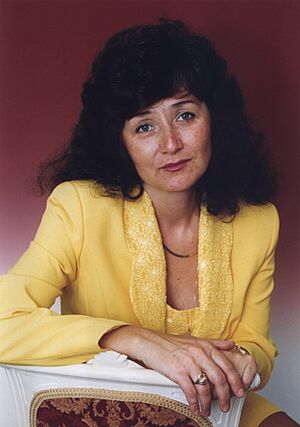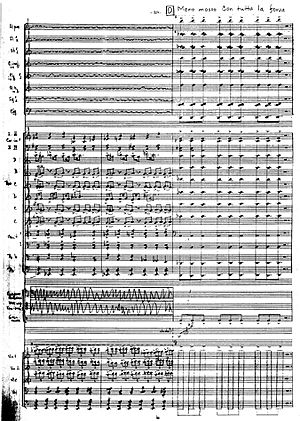Sylvie Bodorová facts for kids
Sylvie Bodorová (born December 31, 1954) is a famous composer from the Czech Republic. She was born in České Budějovice. Since the late 1970s, she has written many different kinds of music. Her pieces include music for single instruments and for large orchestras. Cities, festivals, and groups all over the world have asked her to create new music for them. She also helped start a Czech classical music group called Quattro in 1996.
Contents
About Sylvie Bodorová
Sylvie Bodorová studied how to compose music at special schools in the Czech Republic, like the Janáček Academy of Music and Performing Arts in Brno and the Academy of Performing Arts in Prague. She also continued her studies in other countries, including Gdańsk and Siena, Italy. Later, she learned from Professor Ton de Leeuw in Amsterdam.
She used to teach music at the Janáček Academy. In the 1990s, she was a visiting professor at the University of Cincinnati College-Conservatory of Music in the United States. The music library there even has copies of her music.
Her music has been played all over the world, even in Antarctica! In 1997, her guitar piece "Homage to Columbus" was performed there. She has won several awards for her music. Many festivals and cities have asked her to write new pieces. For example, she wrote Megiddo - Piano Trio and Terezin Ghetto Requiem for the Warwick Festival in England.
In 1999, she wrote music for cities like Buenos Aires (Concierto de Estío) and Bochum, Germany (Saturnalia). Her piece Terezín Ghetto Requiem was very successful. Because of this, the Prague Spring International Music Festival asked her to write a large musical story called an oratorio. This oratorio, Juda Maccabeus, was performed in a big cathedral in Prague in 2002. Another piece, Concerto dei fiori for violin and strings, was first played at the Prague Spring Festival in 1997.
Sylvie Bodorová has continued to compose many important works. In 2005, she wrote Bern Concerto for Camerata Bern. She also wrote a piano concerto called Come d'accordo in 2006. She created a song cycle called Slovak Songs for famous singers Štefan Margita and Gabriela Beňačková. In 2008, her oratorio Moses was first performed at a music festival.
In 2009, she wrote Carmina lucemburgiana for strings. This piece was requested by the government of Luxembourg. In 2012, she finished Lingua angelorum, a song cycle for a baritone singer and a large orchestra. This piece was inspired by Rudolf II, Holy Roman Emperor. It was written for the famous singer Thomas Hampson. She also arranged some of Antonín Dvořák's music for Thomas Hampson, which was played in Vienna in 2013.
Sylvie Bodorová was part of the Quattro group of Czech composers. She is also helping to restore the birthplace of the famous composer Gustav Mahler in the Czech Republic. She has even composed and arranged many pieces specifically for children. Her music often includes parts that remind listeners of Johann Sebastian Bach's music. She also uses rhythms from Roma and Eastern European music, as her family has roots in Hungary.
Music by Sylvie Bodorová
Operas
- The Legend of Catharine of Redern, a long musical story for the stage (2014).
Orchestral and Concerto Works
- Plankty, music for viola and orchestra (1982).
- Pontem video, a concerto for organ, strings, and drums (1983).
- Messaggio, a concerto for violin and orchestra (1989).
- Concerto dei fiori, a concerto for violin and strings (1996).
- Juda Maccabeus, a large oratorio for singers, choirs, and a big orchestra (2002).
- Mysterium druidum, a concerto for harp and strings (2003).
- Bern Concerto "Silberwolke", a concerto for violin, viola, and strings (2005).
- Come d'accordo, a concerto for piano and orchestra (2006).
- Moses, a large oratorio for singers, choirs, and a big orchestra (2008).
- Carmina lucemburgiana for strings (2009).
- Lingua angelorum, a song cycle for a baritone singer and orchestra (2012).
Chamber Music
Chamber music is written for a small group of instruments.
- Giľa Rome, a meditation for solo viola (1980).
- Dža more, a gypsy ballad for solo violin (1990).
- Concerto dei fiori, a version for violin and piano (1996).
- Megiddo for violin, cello, and piano (2001).
- Terezín Ghetto Requiem for baritone voice and string quartet (1998).
- Rotationes for clarinet, violin, viola, and cello (2012).
- Vertumnus, five pieces for a brass quintet (2004).
Vocal and Vocal-Instrumental Works
These pieces feature voices, sometimes with instruments.
- Terezín Ghetto Requiem for baritone and string quartet (1998).
- Ama me, a song cycle for baritone or mezzo-soprano and piano (1999).
- Juda Maccabeus, a large oratorio (2002).
- Sadaj, slnko, sadaj – The Setting Sun, seven Slovak folk songs for voices, harp, and piano (2005).
- Amor tenet omnia, three pieces for mixed choir, two pianos, and percussion (2007).
Guitar Works
- Baltic miniatures for solo guitar (1979).
- Fairy tales for flute and guitar (1980).
- Violet diary for solo guitar, written for children (1985).
- Elegy for guitar solo – Homage to Columbus (1988).
- Concierto de Estío for guitar and strings (1999).
Harp, Piano, Organ Works
- Musica per organo (1982).
- Pre-Visions, for piano trio (1983).
- Mysterium druidum, a concerto for harp and strings (2003).
- Come d'accordo, a concerto for piano and orchestra (2006).
- Three Sonnets Sonata for Piano (2013).
Music for Children
- Cat colouring book for piano (1974).
- Tůňka – Small swimming hole, a small opera ballet for children (1976).
- Violet diary Cycle of children compositions for children (1985).
- Carousel for piano (2000).
Arrangements of Other Composers' Music
- Antonín Dvořák Gypsy Melodies, Op. 55, arranged for baritone/soprano and chamber orchestra (2012).
Recordings of Her Music
Many of Sylvie Bodorová's compositions have been recorded. This means you can listen to them on CDs or online. Some of her recorded works include:
- Gila Rome for viola solo (2021).
- Planctus for Viola and Orchestra (2020).
- Slovak Duets (2019).
- Vallja e malit - Dancing Mountain (2018).
- Symphony No 1, Con le campane (2012).
- Mysterium druidum for Harp and Strings (2009).
- JA RA LAJ – a suite of Slovak, Balkan, and Roma songs (2009).
- Juda Maccabeus (2004).
- Terezín Ghetto Requiem (2004).



